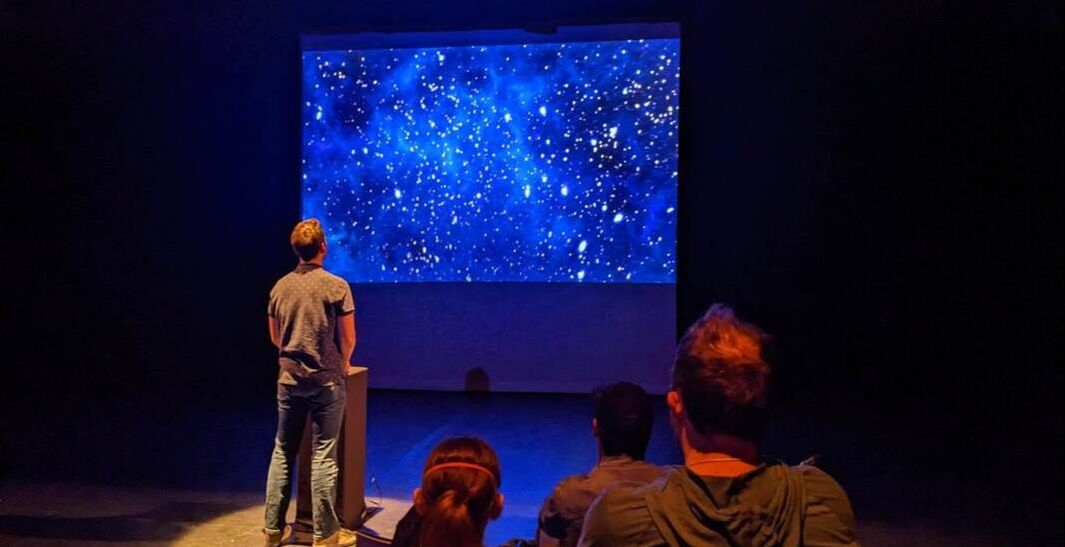asses.masses: a collective audience-player blog (FOLDA 2023)
|
From a nearly eight-hour show, there is lots to say, but I’m going to focus on moments of negotiation in the audience-participant group. To begin, it is important that the show is set in a theatre, in a black box studio theatre. We are seated in theatre chairs, in tiered rows. There are black curtains and we are facing forward, facing the screen in a mass shoulder to shoulder. The lights on the audience are dim. Our initial framing is as spectators. We could be watching a play or a movie. I was surprised by how quickly the first player stepped up. When I first saw the show in a demo at the Banff Centre for the Arts in November 2019, the invitation to step up and participate was a little more forbidding. Well, not forbidding, perhaps slightly cool—as it has arms crossed “show me,” but not warmly obvious. With opening remarks from Adrienne Wong as one of the festival’s curators and Milton Lim as one of the show’s creators, the audience is primed to participate and so when the request is made, there is no hesitation. I was curious as to how often the controller would switch hands. This is a key nexus point of social negotiation by the audience-herd. Who will lead and for how long? At one extreme, I can imagine a scenario where one person plays the whole show/game. (For an eight-hour piece this seems unlikely—also exhausting. However, in Banff one person did play the full 45-min experience at that time in both the showings that I saw.) I realized here that precedent is powerful. The first person played the whole first episode and after that each subsequent person also completed the whole episode. There were a few attempts to hand off the controller mid-episode, but the offer seemed feeble and any potential taker didn’t move fast enough to make their desires to play known before the current player resumed. There is also potential for more frequent changes of possession of the controller. For example, taking turns playing the mini-games or allowing a more “expert” or agile player to navigate a difficult sequence. Of course, this question of who leads, and the changes of leadership is central to the plot of the show. Obviously, there are asses and we are the masses. But we also see the first leader, Trusty Ass, die by falling down the well, early in the evening, near the end of episode 1. Different asses assume leadership of the herd at different points in the narrative. It is Smart Ass who orchestrates the escape from the abattoir in episode 7. And the performance culminates with Baby Ass who gathers talking points for a crowdsourced manifesto in Episode 10. Another curious point of negotiation is offered in the breaks between episodes. Every two episodes, there is a black screen with text that tells us that there will now be a pause of an undetermined length, and press X to begin when ready. Like the controller hand-off, the audience-herd is left to make choices that bring the individual and the collective into tension. It only takes one person to press X and start the show-game again. On the other hand, it seems only fair for the whole herd to be present when the new episode begins. At the end of Episode 4, dinner-type food was provided. People gathered up their sandwiches and dessert cookies and sat in groups – some inside the theatre, some in the lobby, some even outside on the patio – to eat. This break went on for some time. (I timed it at 45 minutes.) A person approached our table and said, “We might be starting again soon.” This is very nuanced language. It doesn’t say “ I want to start now.” or even “I think we should start now.” or “I’m going to start. You should come now if you don’t want to miss the beginning.” Our table took this is as a prompt to stand up and return to our seats. Some others did not get the message (either directly or implicitly) and I noticed five or six people who missed the beginning by about five minutes.
The last type of participant-behaviour, I want to note are what I’m going to call audience mini-games. In parallel with (and sometimes in the gaps in between) the audience created and played their own games. During an early episode, a bag of chips meandered independently around the audience rows. Not knowing whose chips these were didn’t matter and people helped themselves. Later on, a technical glitch necessitated a very short two minute pause in the game. The audience decided to fill the time by quizzing the temporarily unoccupied player-leader, asking “Which ass do you most identify with?” and “What podcast are you liking at the moment?” In a brief lull just before the final episode, one audience member started taking friendly bets about what time the show would finally end. (With my guess of 11:37PM, I won!)
This is just a short list of my personal observations of how this group of participants on this one night responded to the play-game context. I’d love to track this over more sessions and see if how the audience starts has influence on how we continue.
2 Comments
|


 RSS Feed
RSS Feed
